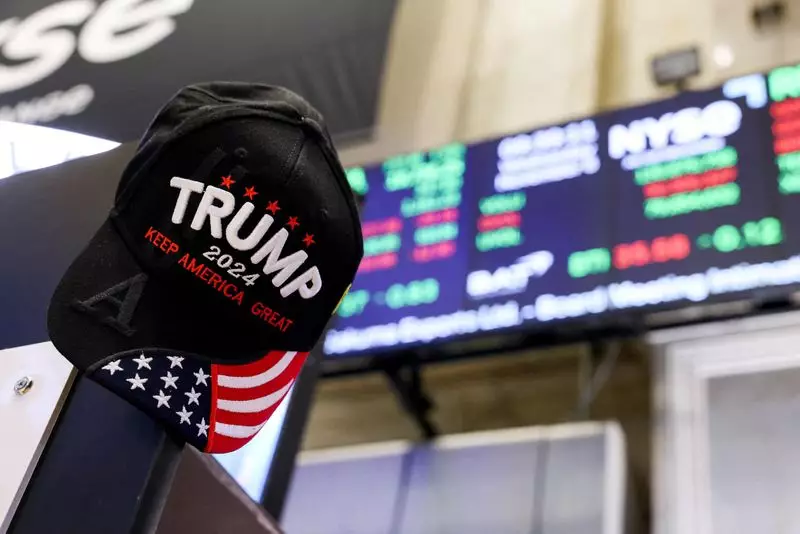The landscape of global finance appears to be shifting in favor of U.S. equities, as they extend their lead over international counterparts. This phenomenon has been particularly pronounced since the election of President-elect Donald Trump, whose economic agenda holds the potential to bolster U.S. stock performance even further—provided that domestic policies do not ignite a trade war or exacerbate the federal deficit. In a year marked by extraordinary gains, the S&P 500 index has risen by more than 24%, significantly outperforming benchmarks from Europe, Asia, and emerging markets, highlighting a critical moment in the health of the American stock market.
At an impressive valuation of 22 times expected future earnings, the S&P 500 currently boasts its highest premium over the MSCI index, which tracks over 40 countries, in over two decades. This valuation differential underscores a growing divergence in market optimism surrounding U.S. corporate earnings, particularly noticeable within the technology sector, where robust advancements in artificial intelligence are driving stock price surges for tech giants like Nvidia. This stark contrast in valuation signifies investor confidence in the resilience and growth potential of U.S. companies.
However, it is crucial to consider the implications of such lofty valuations as market dynamics evolve. If U.S. stocks maintain their current trajectory and the anticipated earnings growth materializes—projected at 9.9% for this year and 14.2% for 2025 according to industry analysts—then the current valuations may be justified. On the other hand, should growth falter or geopolitical tensions escalate, investors could face significant risks.
One of the fundamental elements propelling the U.S. stock market is the undeniable profit edge of corporate America. The expectations for substantial earnings growth starkly contrast with those for European counterparts, where projected increases stand at a mere 1.8% this year and an anticipated 8.1% for 2025. The disparity between the two regions can primarily be attributed to the dominance of large U.S. technology firms in driving profitability. Companies like Apple, Microsoft, and Amazon collectively represent a market value exceeding $14 trillion, dwarfing the combined value of the entire STOXX 600.
In the broader economic context, while the U.S. economy is forecasted to grow by 2.8% in 2024, many European economies are stagnating, thus amplifying the appeal of U.S. equities. This growth differential can influence not only investment strategies but also broader perceptions of economic viability, lending an aura of invincibility to the ongoing bullish narrative surrounding U.S. stocks.
The political environment in Washington, characterized by a Republican stronghold, is poised to play a pivotal role in shaping the future of U.S. stocks. Analysts posit that Trump’s ambitions for tax cuts and deregulation could accelerate economic growth, attracting more investors to American equities. Some strategists advocate for overweighting U.S. stocks in investment portfolios, predicting that these policies may enhance performance in the coming year.
While there is optimism surrounding the potential for growth, concerns regarding the implications of Trump’s agenda linger. Tariffs on imports could provoke retaliatory measures from trading partners, sparking a trade war that may ultimately harm U.S. growth prospects. Thus, although the potential for short-term gains is significant, this geopolitical uncertainty adds a layer of complexity to long-term investment strategies.
Despite the prevailing bullish sentiment, the U.S. stock market is not immune to vulnerabilities. Potential overhauls to fiscal policy could induce market destabilization, raising questions about sustaining the momentum U.S. equities have established. Concerns that significant tax cuts could exacerbate the national deficit have already catalyzed fluctuations in government bond yields, signaling investor apprehension.
Moreover, if U.S. stock valuations rise too steeply, the contrasting appeal of undervalued international equities could draw investors away from American markets. While the long-term trajectory remains favorable, the current environment necessitates vigilance as market conditions evolve.
Overall, the U.S. stock market stands at a crossroads characterized by significant opportunity and pronounced risk. The exceptional performance of U.S. equities, driven by a combination of strong corporate earnings and a favorable political climate, presents a compelling investment narrative. However, as the global economic landscape shifts, market participants must navigate a myriad of potential challenges. The balance between seizing opportunities and mitigating risks will ultimately determine the trajectory of U.S. equities amid a complex, interwoven world economy. Investors must remain cautious yet optimistic about this dynamic market as it continues to evolve.

